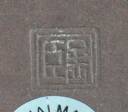Old time pottery, Ming pottery other Antique pottery from Shipwrecks in Asian waters, its proper marine archeology and research provide more data about China's and Southeast Asia's maritime trade. This include the ship's Earthenware, its trade goods of underglaze pained wares, unique Yixing teapots, famous celadon and the ever popular Chinese porcelain
To read more about the pottery history, archeology and related research, click on below pottery picture.
Old time pottery, celadon, antique Chinese porcelain and other Asian pottery including Earthenware, Underglaze and Yixing teapot
Earthenwares
Earthenware is the earliest type of pottery known to have existed for 10.000 years. Secondary clay was formed on the wheel or rolled into strings, laid on top of another to form the pot. Earthenware's were commonly fired in simple open pits and therefore found in most of our old civilizations. Firing temperature normally reached 400 to 700 degree Centigrade but some types are know to have been fired at higher temperatures.
Decorations was often limited to cord marks, made by pressing a cord into the wet clay. Elaborate cord patterns was similar in many coutries and over wide areas and therefore difficult to assign to a specific place.
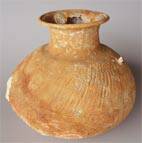
Most of the earthenwares found on 14 - 16 th century shipwreck usually contains some remnants of food or other on board necessities. The limited number found suggst that earthenwares were never made for export.
For more detailed information about underglaze black painted wares, please go to our articles on: http://www.maritimeasia.ws/turiang/sukhothai.html
Long before the Chinese made blue and white porcelain using cobalt, a black iron oxide was used to paint motifs below a clear permanent glaze, thus protecting the decorations for long times. This technique, used at Cizhou in northern China, developed independently from the celadon production in southern China.
By the 14th century, the underglaze technique appeared in Sukhothai and Sisatchanalai in Thailand, and in Vietnam. At Sukhothai, production continued until the end of the 16th century. Indigenous underglaze motifs included stylised flowers and fish. Fish, and the chrysanthemum representing long life and happiness, were preferred at Sukhothai and Sisatchanalai. In Vietnam, a flower motif was common.
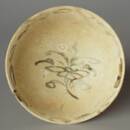
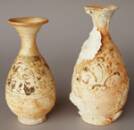
Sukhothai flower motifs were popular in the Southeast Asian markets
Vietnamese bowls and Sukhothai plates were plentiful on the Turiang shipwreck
It is possible that the underglaze decoration technique (painting with oxides and then applying glaze) arrived in both Thailand and Vietnam with immigrating Chinese potters. The Turiang shipwreck (+/- 1370) is the first known case of similar Vietnamese and Thai underglaze decorated products being found together and clearly contemporary.
Other underglaze decorated wares from Sukhothai were found on the Longquan, Xuande and Singtai shipwrecks.
Underglaze painted ware of this period is rare. Collectors beware: modern Thailand produces many copies, often sold as genuine antiques.
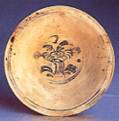
Sukhothai plate with similar flower mofifs
as those in Vietnam.
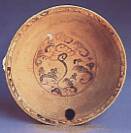
Sukhothai and Vietnam used the shevron scroll to decorated the rim
15th - 16th Century Celadon wares
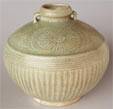
Royal Nanhai (1460) was found loaded with celadons from the Sisatchanalai kilns in Thailand
Celadon is a western word used originally to describe the green glaze of ceramics from Longquan in China. An ash glaze (made of clay mixed with wood ash), it requires 2-5% iron, and must be fired in a reduction atmosphere.
A green glaze was in use in China by the 7th century, and during the Song dynasty (960-1280) this developed to a jade-like substance.
Celadon, like jade, was believed to have magical and protective powers. It was said that celadon would ring if danger was approaching, and would change colour to warn of poisoned food. No wonder it became so popular.
Celadon technique was arguably perfected by the 12th and 13th century, when it depended solely on balanced form. By the 14th century, motifs such as lotus flowers and stylised chrysanthemums were incised for decoration. From the early-14th century, blue-and-white porcelain was introduced, and gradually displaced the underglaze black tradition.
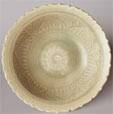
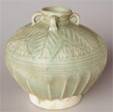
The Longquan (1400)
was loaded with similar celadons but of an earlier date
Celadon production in Thailand seems to have started in the later part of the 14th century - around the time of the 'Ming ban' of 1371 when emperor Hongwu prohibited the Chinese from continued overseas trade. Many similarities support our contention that this was no coincidence, and that Chinese migrants were responsible.
Chinese celadon was found on the Turiang and Longquan shipwrecks. Sisatchanalai celadon was recovered from the Nanyang, Longquan and Royal Nanhai shipwrecks.
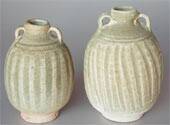




The Royal Nanhai ship carried celadon with excuisite incised decorations. This period (1460) seems to be the peak of its techique and craftmans ship
Antique teapots and other Yixing wares
Yixing is a large pottery complex in Jiangsu province, China, that despite its old tradition is not not as well-known as other ceramic centers. One of the reasons for the limited awareness among antique lovers is its comparatively little exports. Tea lovers all over the world do however appreciate Yixing teapots and consider them the very best of teapots. These teapots are still made today although the 'old' granular clay, making the best of tea, is long ago exhausted.
There are two distict differences between ordinary pottery and Yixing wares. The first is the type of clay used. The second: most wares are made by hand and not on a potters wheel.
Yixing 'purple' clay is if fact a mixure of the purple soil, the green soil (from the mountains of Yixing) and the red soil. The purple clay arrives from around Lake Tai and the mixture of the three different types of minerals is still a safely guarded secret.

10.5cm high Yixing teapot from
the Desaru (1830) shipwreck
Traditional Yixing teapot clay particles usually range from 0.2 to 0.3 mm in size. The porous nature of this clay is particularily suitable for teapots as the pot absorbs the flavour, smell, and color of the tea that is brewed in it. The repeated use of such teapot makes it better everytime. Many old Chinese people still carry with them their favorite teapot whenever they travel.

9.5cm high Yixing teapot from
the Desaru (1830) shipwreck

Granular clay make it less suitable for forming on a potters wheel. Instead, the potter will flatten the clay by hand, cut to round and rectangular shapes and join them in a mould. After setting in the mould, the pot its individual shape by beating it into its desired shape. A traditional Yixing teapot it thus 'handmade' but formed in a mould.

6.5cm high Yixing teapot from
the Desaru (1830) shipwreck
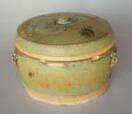
Other Yixing wares include garden pots, bowls and covered boxes. Some of them copying the famous Song-dynasty Jun ware. While the clay in these pots are not made from the famous purple clay, it is granular, porous and allows water to slowly penetrate. These pots too are made in moulds from a circular bottom piece joined with a flatt rectangular side piece.
Yixing brown-glazed garden bowls
from the Desaru (1830) shipwreck
Yixing brown-glazed garden pot
and covered box from
the Desaru (1830) shipwreck
To view Yixing Teapots for Sale, go to: Teapots for sale
All Yixing teapots recovered from the Desaru shipwreck, tentatively dated to 1830, are marked in the base with the potters name. This mark will sometimes show the name of the factory and include a Chinese poem, most frequently associated with montains, spring water and the like. The marks shown below represents all the different markings on teapots from the Desaru shipwreck.


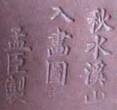
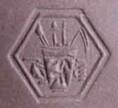

Mark 1
Mark 2
Mark 3
Mark 4
Mark 5
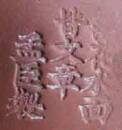
Mark 6
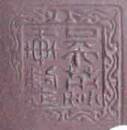
Mark 7
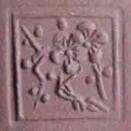
Mark 8 Mark 9 Mark 10
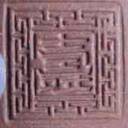
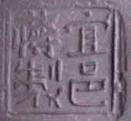
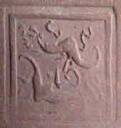
Mark 11
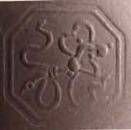
Mark 12
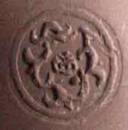
Mark 13.
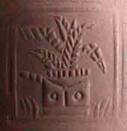
Mark 14
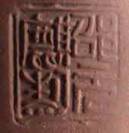
Mark 15
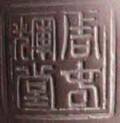
Mark 16
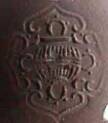
Mark 17
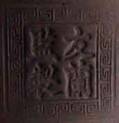
Mark 18

Mark 19

Mark 20
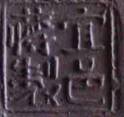
Mark 21
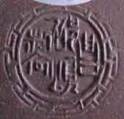
Mark 22

Mark 23
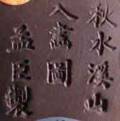
Mark 24
Mark 25

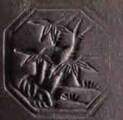
Mark 26
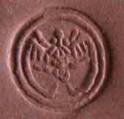
Mark 27

Mark 28
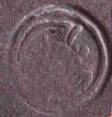
Mark 29
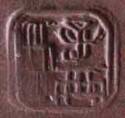
Mark 30
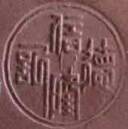
Mark 31
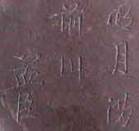
Mark 32
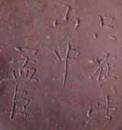
Mark 33
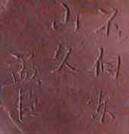
Mark 34
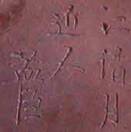
Mark 35
Porcelain is the best known type of ceramics. Porcelain is sometimes referred to as 'blue and white' from its contrasting color or 'Underglaze blue' from its blue cobalt oxide below the glaze.The reason Chinese porcelain becomes so famous could probably be found in the Europeans and American's East India ships, trading with China from the 17th century. At that time, China had already exported blue and white porcelain to the Middle East and Southeast Asia for three centuries. Despite this great success in ceramic history, porcelain was not the reason the early European's were drawn to Asia. It was spices!
The first Portuguese merchants to visit China eventually realized the value of the "white gold" and started importing limited quantities for the nobles of Europe. It was however first in 1603 that the Dutch East India Company (VOC) sent a load of porcelain to Amsterdam where it was sold for enormous profit. from that date onwards million of pieces of porcelain was exported to Europe. For more information about an early Portuguese shipwreck, please visit: The Wanli Shipwreck.
Following that date Chinese blue and white porcelain become a much desired product in Europe and the United States which eventually interested antique collectors. China's earlier and traditional ceramics like the underglaze black decorated wares and celadon, is still today not that well-known.
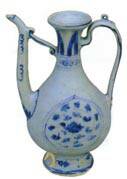
Chinese porcelain ewer
from the early 16th century.
Although the reign mark in the base suggest manufacturing during emperor Xuande (1425-1436) reign, the ewer was made one century later


During the early part of the Yuan dynasty (1280-1368), potters at Jingdezhen, China, succeeded in decorating whitish local clay with blue cobalt oxide under a clear glaze, overcoming earlier technical difficulties relating to both the colours and the glaze. The date of this major event in ceramic history is much debated, but it is believed that it could have been as early as AD 1300.
Production of blue-and-white ceramics developed rapidly during the Ming dynasty (1368-1644), greatly influenced by the imperial court and its stringent requirements. Although 'imperial' kilns in the Jingdezhen area also made export ware, those at Shantou (Swatow), Dehua and other parts of Fujian seems to have made wares primarily for the Southeast Asian markets.
Transitional period
porcelain bowls
Following the death of emperor Wanli (1573-1619), unsettled dynastic politics eventually allowed Manchurians to conquer the country (the Qing dynasty, 1644-1912). Some of the most important imperial kilns at Jingdezhen closed, and were first reopened by emperor Kangxi only in 1663.
The period between 1619 and 1663, when most imperial kilns were closed, is referred to as the 'transitional period'. It is believed that the imperial potters, temporarily without work, assisted the private kilns with the manufacture of blue-and-white ceramics. The sudden release from the strict guidelines of the court gave craftsmen the opportunity to express individual talents. A new spontaneity can be seen in the artistic freedom of the painting, the choice of motifs, and the quality of brilliant blue cobalt under a clear and smooth glaze.




Traditional cobalt blue motifs from the
'Transitional' period
With the entry of European traders in China, the Chinese potters painted just about anything the "strange white people" wanted. Without any appreciation for Chinese tradition, the foreigners specified their own motifs and the European export porcelain appeared accordingly. With greater success in Europe and later in the USA, it accelerated the devolution of Chinese potting tradition. The exported porcelain was Chinese alright but only made by Chinese people and local clay. No tradition, no individualism and and long gone was the mythological motifs and the traditional floral designs the Chinese themselves had appreciated for centuries before. "The last ship to depart China with traditional Chinese motifs painted on porcelain was the (1625) Wanli shipwreck"
An interesting reflection on the age of China's and Southeast Asian traditional pottery:
The Turiang ship (1370) that was loaded with Chinese celadon and Thai underglaze black wares, sank more than a century before Christopher Columbus found the 'New World'.
When the Swedish East India Man "Gotheborg" sailed to China in 1745 to buy what is antiques today, she sailed right over the Royal Nanhai (1460) shipwreck that, already then had three century old celadons onboard!


To view genuine old time pottery and other antique shipwreck ceramics, please visit our Artifacts for Sale Pages.
For a fuller description of porcelain production at Jingdezhen; "The porcelain center of the world" click here
For a more complete desciption of porcelain production at Jingdezhen, refer to the updated "Jingdezhen" section on the Wanli Shipwreck Site.
THE THE ONLY PLACE WHERE YOU CAN BE SURE TO BUY GENUINE ANTIQUES
Nanhai Marine Archaeology Sdn. Bhd. was incorporated on the recommendation of the Malaysian authorities. This was done in order to formalize and to expand on the company’s researcher’s extensive knowledge of Asia’s ceramic developments and maritime trade.
The company’s researchers have been engaged in the search for historical shipwrecks for more than two decades and another decade researching maritime trade. Most of this work is concentrated to the South China Sea, a virtual highway for ancient shipping linking China to India, the Middle East and Southeast Asia in an extensive maritime trade system. This ancient trade started sometime around the 4th century and lasted well into the 19th century.
Following a successful shipwreck discovery, the company obtain a government permit to excavate the wreckage, and then carry out detailed marine archaeological procedures in recovering the artifacts, mapping the ship's remains and securing other data for future research. After each concluded project and following conservation of recovered artifacts, we search for and pinpoint ruined kiln sites and compare its wasters with the recovered ceramics until we are satisfied we located the place in which the shipwreck pottery was made centuries earlier.
As such we have precisely located a kiln sites in Sisatchanalai, northern Thailand in which our Royal Nanhai and the Nanyang shipwreck celadon ware was made around AD. 1380-1460. (See videos on: http://www.ming-wrecks.com/photopage.html ) Other kilns was located in Sukhothai where production wasters matched the fish and flower plates found on the Turiang and the Longquan shipwreck. These unique underglaze decorated wares was made at those exact kilns 600 years earlier! Our latest shipwreck cargo; The Wanli Shipwreck, of Chinese blue and white porcelain, was likewise pinpointed to the Guangyinge kiln site in Jingdezhen, China.
Our arrangement with the Malaysian authorities is such that we finance all operations and train young Malaysian nationals (on our initiative) in maritime archaeology and related research. After giving all unique and single artifacts and thirty percent of all recovered items to the National Museum (and assisting with exhibitions of artifacts from each project) we are allowed to sell our portion of the recovery to finance future projects. The findings from ongoing research and the compilation of reports, books and catalogues are available on these pages as well as on a separate Internet site: http://www.maritimeasia.ws
Due to the unquestionable authenticity and precisely dated shipwreck pottery, many International Museums now display our shipwreck pieces as reference material.
The artifacts sold on this website are therefore legally and properly excavated and can be supplied with an export permit from the Department of Museum in Malaysia should this be required. This unique working arrangement makes us one of the few Internet sellers that sell from own excavation and issues a meaningful Certificate of Authenticity with all artifacts with a serial number.
So, if you are interested to purchase some of our Antique porcelain, old time pottery or other shipwreck artifacts from the Song dynasty, Ming porcelain or Chinese blue and white porcelain or the famous Yixing teapots, you can rest assured that every piece is excavated through proper archaeology by our own staff. We do not sell anything that is not excavated by ourselves or properly recorded and researched before offered for sale so every piece comes with the “Best possible provenance”
WE ENCOURAGE YOU TO EMAIL OUR PRINCIPAL RESEARCHER; Sten Sjostrand SHOULD YOU HAVE ANY QUESTIONS ABOUT YOUR POSSIBLE PURCHASE
Underglaze black decorated wares
For more information about Asia's ceramic developments and influences, please go to our articles on: http://www.maritimeasia.ws/turiang/ceramicissues.html#mingban
CLICK ON BELOW IMAGES TO VIEW OUR SALES PAGES
 | ||||
Nanhai Marine Archeology Sdn. Bhd.
CLICK ON ABOVE IMAGES TO VIEW OUR SALES PAGES.
OTHER WEB PAGES RELATED TO ANTIQUE CELADON, CHINESE PORCELAIN,
SHIPWRECK POTTERY AND ANTIQUES FOR SALE














